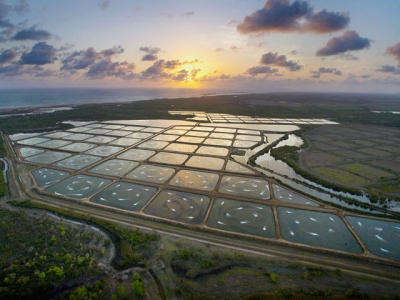What Is the Environmental Impact of Aquaculture?

Editor’s note: This post is part of the Aquaculture 101 series. Aquaculture 101 is an educational campaign that the GAA is carrying out throughout 2019. The mission of the campaign is to spread awareness about basic aquaculture facts and information to those who might not know about aquaculture, or those who might be skeptical of farmed fish. Each month, a blog post, short video, and infographic is released on the GAA website and is shared across social media with the hashtag #Aquaculture101.
Over the past few decades, the environmental impact of aquaculture has been a popular topic of discussion – one that hasn’t always been the most positive. However, the environmental impact of aquaculture is completely dependent upon the species being farmed, the intensity of production and the location of the farm. Additionally, new strategies and technologies have emerged and have proven that it is possible to have sustainable aquaculture.
Fisheries are without a doubt significant natural resources, particularly for parts of Africa and Asia. However, these areas rely heavily on fisheries for food security are places where the population is growing exponentially, meaning there are even more mouths to feed. Fish farming, when done sustainably, can be the answer to filling the gap in seafood supply that stressed fisheries are creating.
Poor practices of years past
In the past, when the aquaculture industry was just getting its footing, certain factors inhibited the industry from producing fish sustainably. The intention of fish farming was never to impact the environment, but to increase food security.
However, environmental problems did arise. There was no shortage of negative press, and these stories have stayed with the public. Common criticisms were related to nutrient and effluent build-ups, the impact of fish farms on local wild fisheries with respect to disease and escaping, and environmental degradation due to the site’s location.
The negative environmental impacts aquaculture has had are nuanced. Nutrient buildup happens when there is a high density of fish in one area. Fish produce waste, and their waste has the potential to build up in the surrounding area. This can deplete the water of oxygen, creating algal blooms and dead zones.
Farmers’ usage of antibiotics to prevent disease created concern about the effect of the drugs on the ecosystem around the cages, including wild fish. Many also worried that the escape of nonnative fish would cause wild fish to compete for food, potentially displacing the native fish.
These were all valid criticisms given that the industry was just beginning to learn how to cope with issues as they came up, as any new industry does.
A new day for aquaculture

Fortunately for the aquaculture industry and for the planet’s well being, much progress has been made in the name of sustainability.
Regulatory agencies have recognized the effects of nutrient and effluent buildup with implementing measures to prevent this from happening. Siting the location of the fish farm in an area with strong currents to disperse the effluent as well as moving the farms from time to time to prevent impacting one specific area more than others are some ways the industry is combatting this environmental issue. Additionally, land-based aquaculture has a minimal impact on local ecosystems.
Antibiotic use is declining, and safe and effective vaccinations have since been developed for farmed fish and are now widely used.
As for the issue of escaped fish from farms, which does still happen occasionally, underwater cameras now closely monitor cages, and divers regularly inspect cages with this in mind.
Positive environmental impacts

Farmed seafood is incredibly resource efficient, especially when compared with other animal proteins (beef, pork, chicken). The feed conversion ratio, which is the measurement of how much feed it takes to produce the protein, is 1.1. This means that essentially one pound of feed produces one pound of the protein. Beef, pork and chicken’s feed conversion ratios vary between 2.2-10. As a result, seafood’s protein retention, as well as energy retention are remarkably high as well.
As farmed fish are closely monitored in comparison to wild fish, farmers have more control over variables. This can positively impact the environment and the fish. Farmed fish are generally free of environmental contaminants like mercury and heavy metals, as they exclusively eat human-processed feed. Fish feed’s toxin levels are regulated.

The farming of filter-feeders, like shellfish, can improve water quality. These creatures eat excessive nutrients in the water, which, in turn, prevent the buildup of effluent. Filter-feeders are often integrated into the farming of other species, like finfish, to use uneaten feed and fish waste as food, offsetting the farm’s environmental impact. This system is called polyculture, or integrated multi-trophic aquaculture (IMTA).
Sustainable fish feeds are on the rise. Fishmeal and fish oil used in feeds may come from trimmings from processing plants. Additionally, substituting plant proteins for fishmeal in feeds is also becoming more prevalent.
Aquaculture’s opportunity
With the industry’s desire to lessen its environmental impact coupled with help of technological development, aquaculture has vastly improved in recent years. Farmed fish should no longer be dismissed as unsustainable. This resource efficient protein can fill the gap in supply to meet the demand of the world’s growing population. The tools are now available to assist farms in developing sustainably, and it is up to farmers to take advantage of them.
Có thể bạn quan tâm
 Advances in ruminant environmental impact reductions
Advances in ruminant environmental impact reductions Examining recent developments in the study of rumen microbial ecosystem, genetic selection
 Soil health importance highlighted in House hearing
Soil health importance highlighted in House hearing Collaboration and continued research vital to helping educate on importance of preserving soils.
 How RAS farming can alleviate environmental pressure in East Africa
How RAS farming can alleviate environmental pressure in East Africa The development of a sustainable aquaculture sector can play an important role in providing livelihoods for people living around Lake Victoria